Or – “Before Marvel & DC Editorial Got All Passive-Aggressive…”
Long before the actual Marvel DC crossovers of the 90’s (most of which were pretty banal affairs, with the exception of the awesome Batman/Captain America), there were a number of unofficial blink-and-you-missed-it crossovers from the creative teams that made the comics. Steve Skeates used the Sub-Mariner’s book to wrap up a plot leftover from an issue of Aquaman he wrote a couple years earlier, while the story of Roy Thomas’ trip to Rutland Vermont crosses multiple universes (a long story I’ll probably get to sooner or later.) But this, my young friends, is the story of the crossover that sorta wasn’t a crossover at all, while allowing Uncle Sam to fistfight Captain America or a reasonable fascimile thereof, thus making comic fans happy.
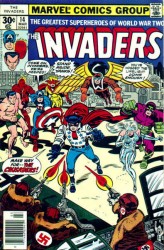 INVADERS #8/#9
INVADERS #8/#9
Scripter: Roy Thomas
Penciler: Frank Robbins
Inker: Frank Springer
Colorist: Marie Severin/Don Warfield
Letters: Joe Rosen/John Costanza
Editor: Roy Thomas
Publisher: Marvel Comics
Cover Price: 30 Cents
Current Near-Mint Pricing: $10
 FREEDOM FIGHTERS #14/#15
FREEDOM FIGHTERS #14/#15
Scripter: Bob Rozakis
Penciler: Dick Ayers
Inker: Jack Abel
Colorist: Uncredited
Letterer: Uncredited
Editor: Jack C. Harris
Publisher: DC Comics
Cover Price: 30 Cents
Current Near-Mint Pricing: $12
Previously, in The Invaders and The Freedom Fighters: World War II will always be important in the lore of superheroes, being the era from which the costumed crime-fighter archetype as we know it sprang. In the Marvel Universe, the greatest heroes of the land (Captain America, The Sub-Mariner, Bucky, The Human Torch and Toro) banded together as The Invaders, and fought their way through Europe, eventually winning the war for the Allies. (It is an established part of Marvel lore that the Torch himself set Hitler on fire in the Bunker in Berlin.)
In the pre-Crisis DC Universe, things get more complicated. Back in the 1940’s, a separate publishing company, Quality Comics, was the home of the characters that would become known as the Freedom Fighters. Quality went south, and DC acquired their superhero assets, leading to the revelation that these heroes existed on the parallel world of Earth-X, where World War II was fought well into the 1970’s, and only ended with the direct intervention of the Justice League of America from Earth-1. (There’s a reason they rebooted this world, after all.) Traveling to that selfsame Earth-1, Uncle Sam and his band of Freedom Fighters have found themselves adrift in a very 70’s kind of identity crisis, complete with existential ennui and high gas prices. At the end of Freedom Fighters #7, the readers were introduced to the latest threat to the Freedom Fighters, a group called The Crusaders!

Is it just me, or is Sparky actually an Oompa Loompa? Each of these heroes bears a striking resemblance to one of the founding members of the Invaders, over in the Marvel Universe, especially Rusty, who is nothing more than a Player-2 palette swap of Captain America’s sidekick Bucky…
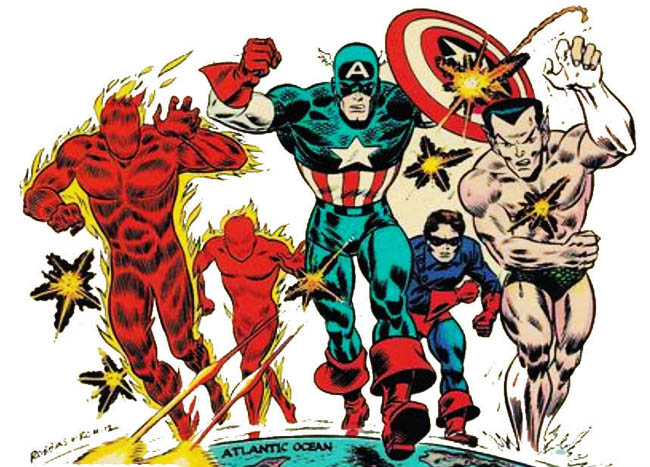
Namor is exhibiting one of his little-known Golden Age abilities there, turning parts of his body completely transparent. Roughly concurrently in their real book, The Invaders likewise run into a group of friendly rival superheroes, also called the Crusaders.
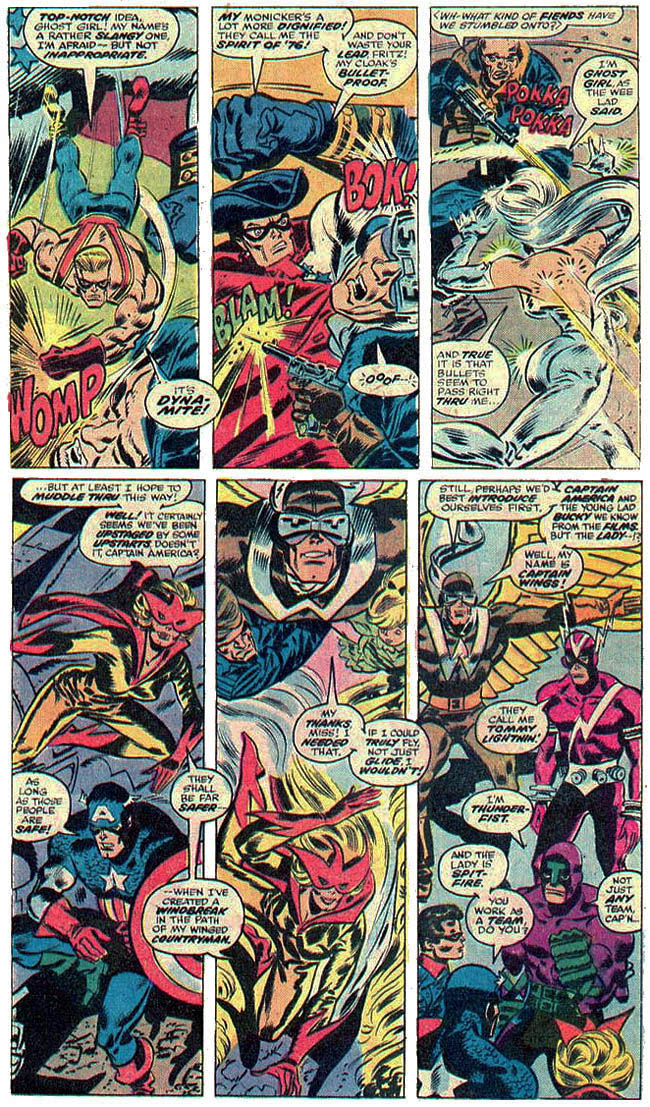
A patriotic powerhouse leader, a tiny titan, a spectral female presence, an energy wielder, a guy who glides and another with explosive fists? I wonder who these characters could possibly be based on?

Of course, Roy Thomas being Roy Thomas, he worked in a few other references as well, as the name Tommy Lightning is evocative of both a 60’s toy line and the Justice Society’s own Johnny Thunder, while both Captain Wings and the Spirit of ’76 borrow their name from actual 40’s heroes from other companies. The Freedom Fighters side of things starts with a classic comic book misunderstanding, as the FF have been framed as criminal by a villain called the Silver Ghost and have legitimately blacked out most of the East Coast. The Crusaders are dispatched to bring the “rogue” heroes into custody…
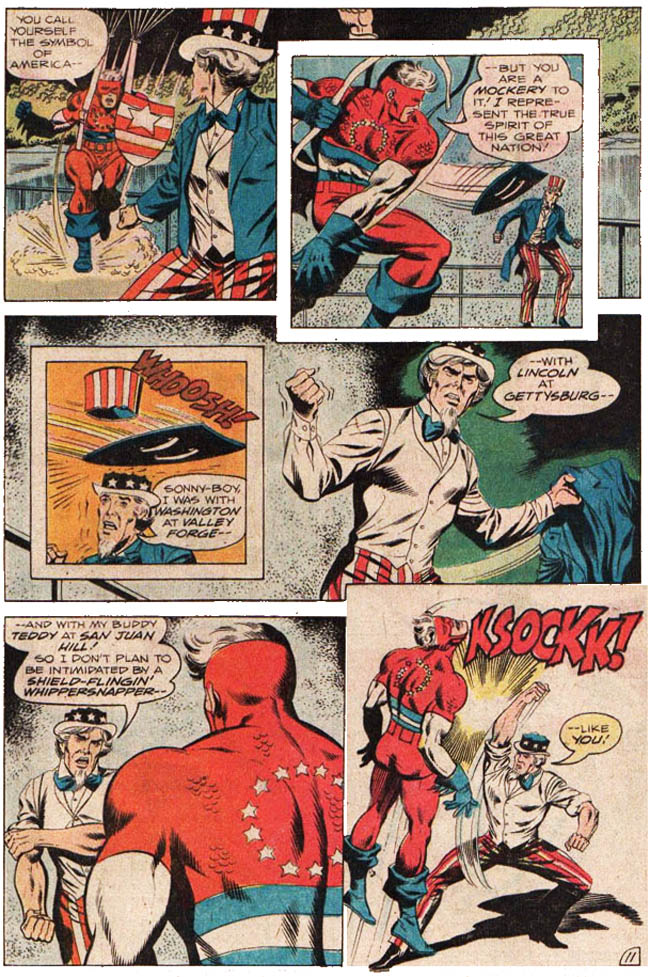
Bob Rozakis’ dialogue is always a hoot, somewhere between the outright looniness of a Bob Haney and the wall of exposition that is Chris Claremont. The faux-Invaders make short work of the Freedom Fighters (thanks mostly to The Ray and the Human Bomb’s unstable powers) leaving Uncle Sam open to a Captain America right-cross (non-union French-Canadian equivalent version.)

Dun DUN DAAAAAH! The Silver Ghost has not only framed the Freedom Fighters, but has led the efforts to bring them in, for some reason. The Americommando/Silver Ghost tries to murder the Freedom Fighters by plugging them into the power grid, causing his heroic partners to question him, leaving them distracted when the FF break free.
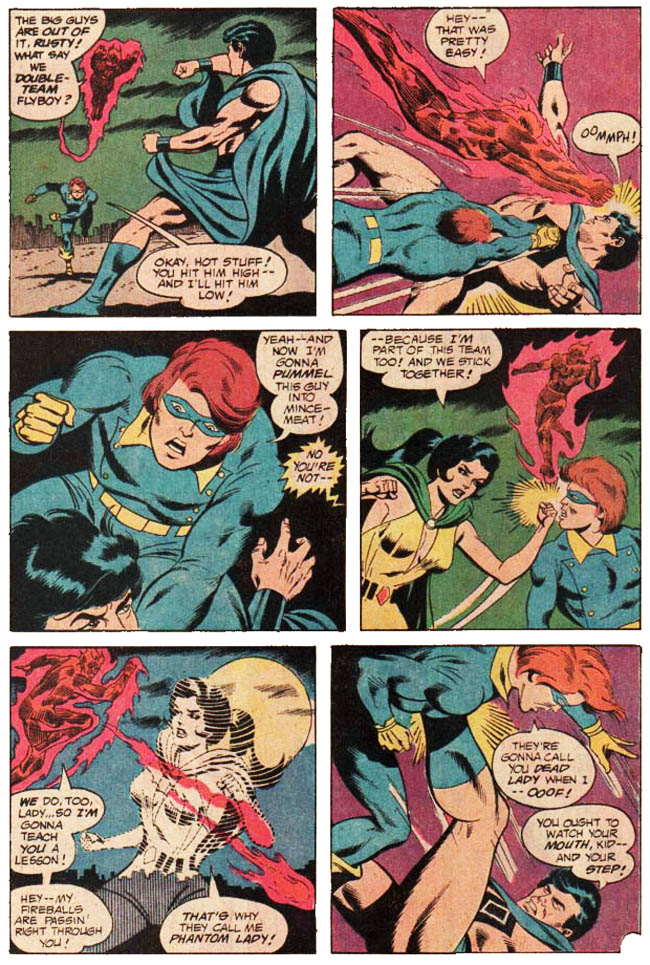
The Crusaders come out of the losing end of this particular battle, and Uncle Sam and his band of brothers try to figure out exactly how these comic book characters came to life…

Two interesting things are at play here: One, the heroes of the Marvel Universe seem to exist as comic book characters in the DCU. This implies that (as Barry Allen found when his comic book hero Jay Garrick turned out to be real) the Marvel and DC universes might exist in the same cosmology, as part of what Mark Gruenwald used to call “The Greater Omniverse.” Secondly, Roy, Lennie, Marvin and Arch are in fact Roy Thomas, Len Wein, Marv Wolfman and Archie Goodwin, the four men who (at the time) had followed Stan Lee as editor-in-chief of Marvel Comics. DC’s Crusaders dropped right off the face of the planet with these panels, and the Freedom Fighters adventures only went on another dozen issues or so.
Meanwhile, in 1941-era Marvel Comics, we find ourselves with a familiar tale, as the Invaders (then the official bodyguards to the King of England) found themselves challenged by a rival team of superhumans called The Crusaders…
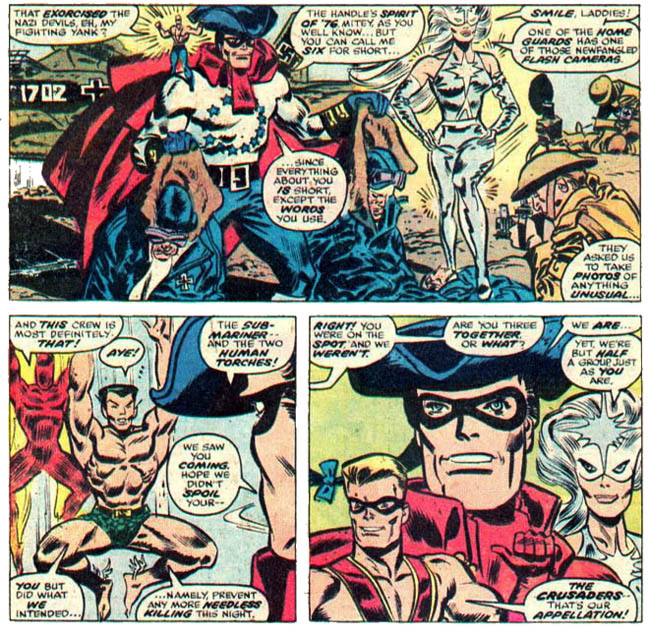
Stephen recently went off on a rant during our discussion of Frank Robbins‘ art in our review of the Captain America: Nomad trade, but the combination of Robbins with Frank Springer in these pages honestly makes my whole face hurt. I suspect that the reasoning was to give Invaders a visual reference to the 40’s era comic books that Roy grew up with, but these pictures are pretty dire…

The Crusaders successfully manage to take down a supposed Nazi spy targeting the King of England, causing a change in the guard at Buckingham Palace, minus the hats that look like black Q-Tips…
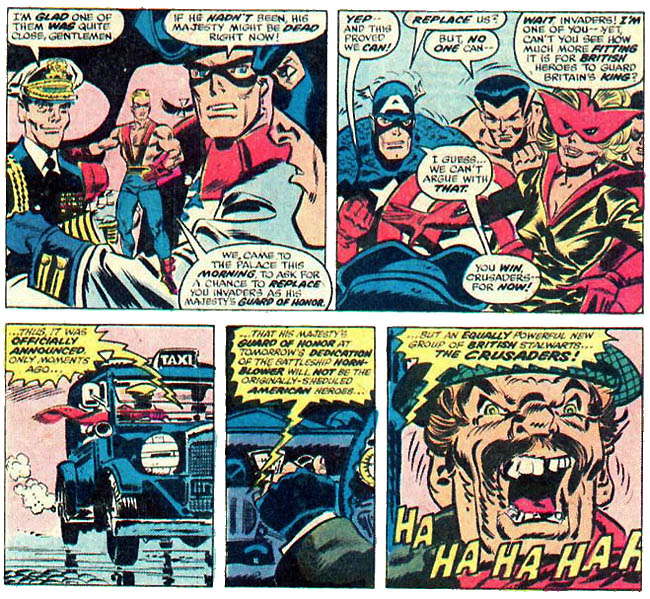
That last panel is literally giving me nightmares. I keep imagining a giant radioactive Terry Thomas trying to peel the flesh off my face with his horrible tombstone-like teeth… *shudder* Aaaaanywaaay, Agent “Alfie” (for that is his name) tries his hardest to turn his charges against their friendly rivals in the Invaders, by smearing our heroes in the best way possible: With the actual true events that happened.
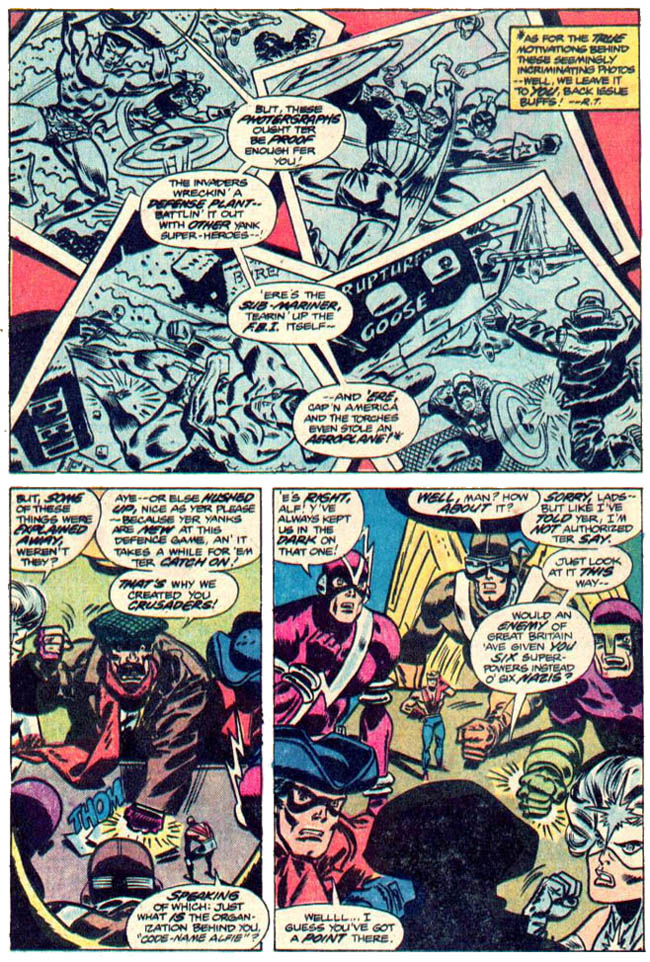
The Marvel Universe is many things, but I suspect that a large part of their expectation of “realistic” stories comes from the fact that everyone’s actions can be interpreted in many ways, and no one is above reproach the way Superman or Batman had been for a couple of decades by this time. Doll-Man-sized Dyna-Mite is the first to discover that their handler is a Nazi spy, and it takes the combined might of Invader and Crusader alike to stop the assassination attempt on the King. Alfie flees the scene, just in time for one of the Human Torch’s patented “Murder? What murder?” power-plays…
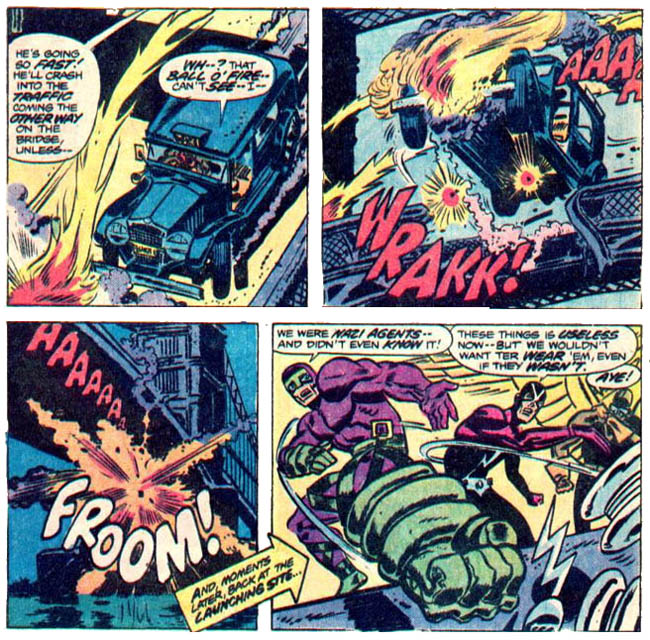
For a superhero, the Torch has a REALLY high body count to his name. Both Crusaders ended up being manipulated by an evil villain, and both Crusaders teams never assembled again. But, much as with the Squadron Supreme, the Marvel versions of the characters actually had a more lasting affect on the continuity. Dyna-Mite returns to action with the Invaders as The Destroyer, and ends up in his regular identity as Roger Aubrey, autocratic leader of the V-Battalion, and is reveals decades later to have been the boyfriend of the Invaders later member Union Jack. William Naslund, the Spirit of 76′, is recruited by the American government after Baron Zemo’s plane explodes in the Atlantic, and becomes the new Captain America while Steve Rogers floats in a chunk of ice. He is murdered in 1946, and replaced by Jeff Mace, formerly the Patriot.
All in all, these issues are a mixed bag. I find that I prefer Rozakis laid-back Freedom Fighters writing style to Thomas’ overwhelming wall of text and trivia and information, but Marvel’s Crusaders seem to be better characters overall. Even if you don’t love the legendary Dick Ayers on Freedom Fighters, the Frank Robbins/Frank Springer art on Invaders is pretty awful to behold and, in an early example of cover stunt-casting, looks NOTHING like the Kirby-pastiche cover art.
Freedom Fighters #8 and 9 earn 3 out of 5 stars overall.
Invaders #14 and 15 still terrify my non-waking hours, and earn 2 out of 5 stars.
Thus, the combined forces of the crossover-that-wasn’t earn a more-than-acceptable 2.5 out of 5 stars overall.
Faithful Spoilerite Question Of The Day: Given the mess that was ‘Marvel Vs. DC,’ wouldn’t it have been better if this WAS the actual first crossover story? I mean, Wolverine defeating Lobo? Come ON!




6 Comments
With Archie’s announcement of ‘New Crusaders’, will you return to the MLJ Heroes soon?
I honestly don’t have any idea what my long-term plans are. Retro Reviews tend to be a spur of the moment thing…
At least we know that Thanksgiving will once again bring our Retro Review of an Asterix title…
Great stuff Matthew. I remember being turned off by Robbins art as a kid, while at the same time being facinated by the concept of Marvel superheroes fighting in World War II. But as an adult, I LOVE the way Robbins and Springer nailed that over-the-top vibe from Timely 40’s books – a style that fit perfectly with Thomas’ goal of the Invaders being the Timely book he always wanted to see.
Those two issues weren’t exactly primo Invaders material, though, so 2 1/2 slices of meatloaf is a pretty fair rating.
Those two issues weren’t exactly primo Invaders material, though, so 2 1/2 slices of meatloaf is a pretty fair rating.
Yeah, there was better stuff in this run. Still, it’s pretty amazing that Invaders broke 40 issues in the first place to me… :)
I love that final panel with the guy laughing! It always stuck in my mind as being a very memorable piece of comic art. Thanks for posting.